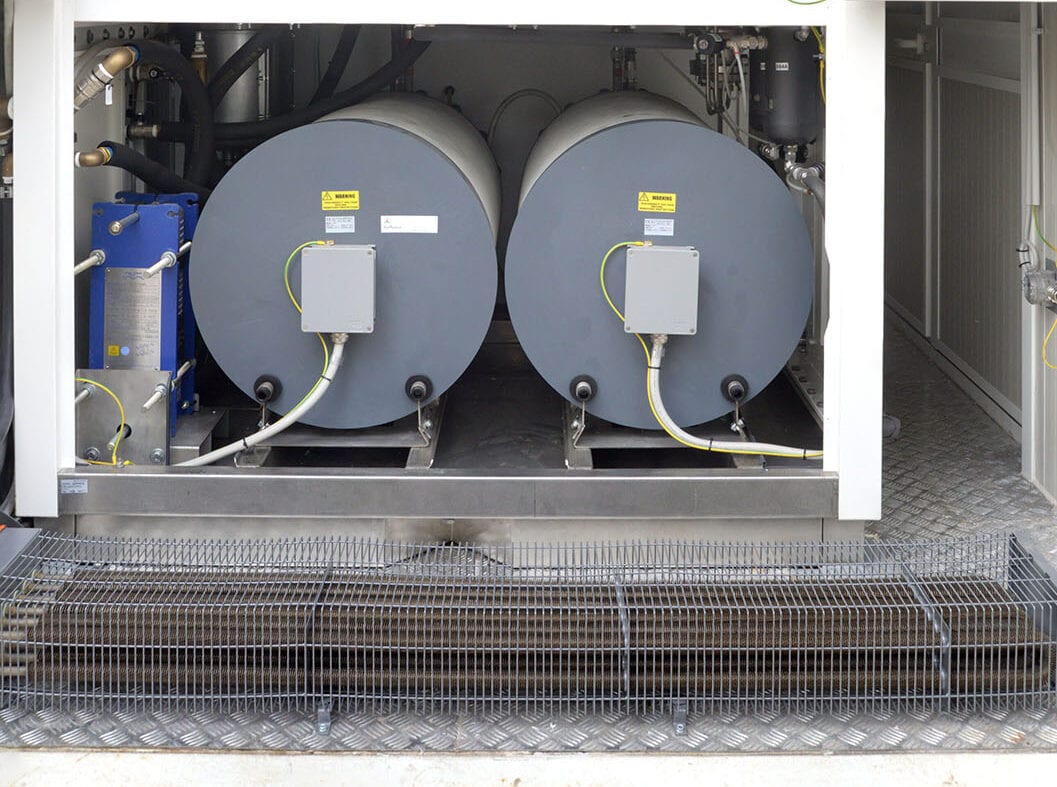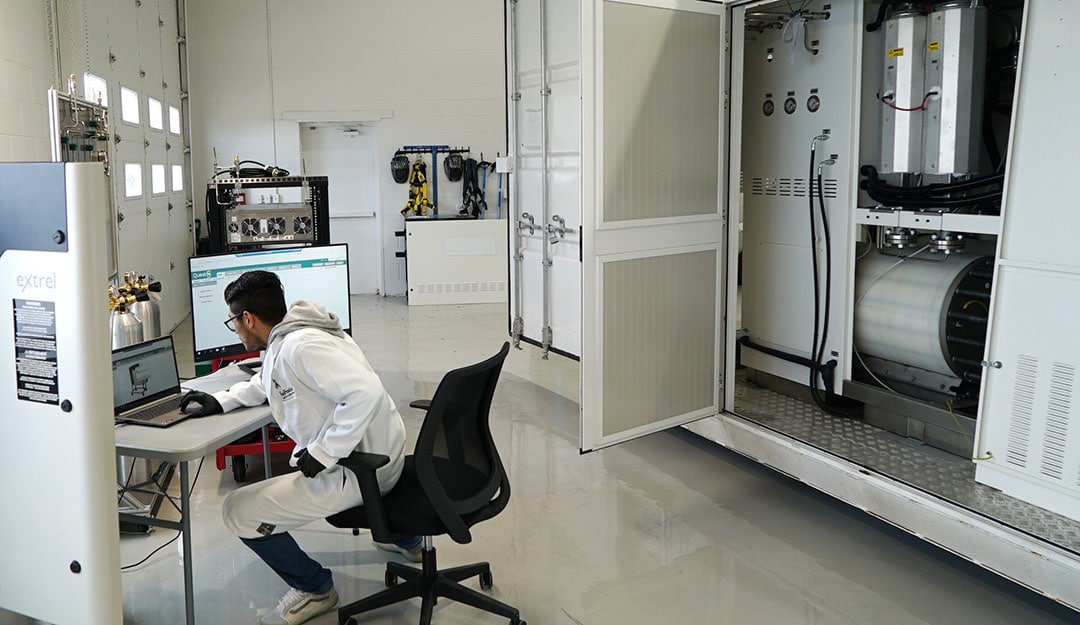Making green ammonia for fertiliser and fuel on-farm

Canadian technology will enable crop farmers to manufacture their own green ammonia for fertiliser from air and water, with renewable energy where possible.
Tracy and Curtis Hiebert, who farm 11,000 acres in Manitoba, Canada, are just like any other crop farmers around the world right now – they are very concerned about fertiliser prices and availability. Fertiliser is the largest crop input cost for grain and oilseed farmers.
That’s why the Hieberts and many other of their peers are extremely interested in revolutionary technology on its way to commercialisation from Ontario-based startup FuelPositive (FP). Its core technology is a scalable, containerised electrically-powered pure/anhydrous green ammonia (NH3) production system, meant to be located right on the farm.
Green ammonia as fertiliser and fuel
It uses only air and water, and can be powered by renewable energy generated on-site where possible. This green ammonia will be applied as fertiliser but can also ultimately fuel internal combustion engines on the farm and can also be used for grain drying systems instead of propane.
“Farmers are fiercely independent and giving farmers control over the means of production of key inputs like nitrogen fertiliser represents a dramatic shift towards farmers’ independence and control in their businesses,” says FP CEO Ian Clifford.
Text continues below image

Full-sized demonstration project
Last year, at the time a full-sized demonstration project was announced on the Hiebert farm, Curtis Hiebert explained how making their own fertiliser will allow them to avoid the wait times for anhydrous ammonia they’ve seen in recent years and also avoid being at the mercy of huge price increases.
“The volatility is what we don’t like,” he said. “It’s scary. The FuelPositive system will give us stability…It’s stabilising the supply and stabilising the price.”
The demonstration system is being powered through electricity from Manitoba’s carbon-free grid in combination with the Hieberts’ 200-kw solar array. The operational interface between the customer and the system is being validated as it’s exposed right now to Manitoba’s extreme cold over the winter and to the warm summer to come.
FuelPositive is receiving CAD$300,000 in federal funding towards building this at-scale demo system, the first of three that are planned.
Pilot project progress

Testing and validation of gas composition and purity (H, N and their combining in NH3) using a mass spectrometer at every step of ammonia production is ongoing. The purity of the hydrogen, produced by the system from water, is key. It has the greatest impact on the performance of the overall technology and directly corresponds to the rate of ammonia synthesis. This part of the system is the most costly in terms of both capital and operating expenses. Two ‘electrolyser’ technologies to make hydrogen are being tested during the pilot project.
FuelPositive is also independently validating its patent-pending green ammonia synthesis converters. First, the separation rate will be validated, by FuelPositive and independently, then control parameters (pressure and temperature), followed by the conversion rate.
The nitrogen system is also being independently validated and commissioned at FuelPositive’s site and will then be integrated into the system as a complete process. Then the entire system will be turned on and validated by FuelPositive and two independent expert organisations.
The technology is the brainchild of Prof. Ibrahim Dincer at Ontario Tech University, which was acquired by FuelPositive. “Dr. Dincer is a preeminent scientist in the green hydrogen and green ammonia space and is always considering the most novel ways of production,” says Clifford. “His facility is world class and we spent considerable time understanding the background and related skills and knowledge of Dr. Dincer and his team.”
Text continues below image

Green ammonia and climate change
FuelPositive also is working on the development of an international standard of accreditation and guidelines for using green ammonia, described by Clifford as “an active and ongoing initiative involving stakeholders at many levels across multiple jurisdictions.”
FuelPositive believes these standards will have a significant impact on the value of carbon credits around the world and will also help farmers to influence local governments to reward the use of green ammonia in their operations.
Indeed, FuelPositive recognises that the current best practises of deep injection of green anhydrous ammonia into the soil provides the most efficient transfer of nitrogen – and with the least greenhouse gas (GHG) effects from the nitrous oxide emissions that result from fertiliser application. The company states that “if our anhydrous ammonia is applied correctly, we believe that our product may be the best option over other nitrogen fertiliser options.”
In late November, FuelPositive announced the appointment of Prof. Mario Tenuta at the University of Manitoba as its agricultural GHG mitigation advisor. Tenuta is the senior national ‘Industrial Research Chair’ in 4R Nutrient Stewardship, a global initiative that strives to help farmers apply the ‘right’ type of fertiliser in the right way and place at the right time.
Environmental impact of grey ammonia
In total, around the world over 200 million tonnes of traditional (also called ‘grey’) ammonia is manufactured and used every year. It is currently the second most-produced chemical globally (after sulfuric acid) and about 80% of it is used as nitrogen fertiliser to grow food.
Grey ammonia production accounts for two per cent of the world’s total fossil fuel use. As a whole, the traditional ammonia industry generates over 420 million tons of CO2 annually. For every metric tonne of traditional or grey ammonia produced globally, almost three metric tonnes of GHGs are emitted.
The production of one tonne of green ammonia in a FP system directly offsets multiple tonnes of CO2e emissions
When asked about the potential environment impact of FP technology, Clifford notes that “decarbonising the production of ammonia, one of the most carbon-intense manufacturing processes on the planet, is hugely significant. The production of one tonne of green ammonia in a FP system directly offsets multiple tonnes of CO2e emissions.”
In addition, localised small-scale production (compared to standard grey ammonia production) of green ammonia on farms also has a positive environmental impact. Only a small number of refineries on the planet currently provide all the ammonia used on Earth, which means it must be transported vast distances from these refineries to the point of use.
And as Curtis Hiebert explains, farmers never know exactly when they will get their delivery of ammonia, how much they will get and how much they will have to pay. Fertiliser purchase is now out of reach for some farmers around the globe.
Text continues below image

Controlled cultivation
In addition to crop farms, FuelPositive sees a “huge global market” for its technology in controlled indoor farming, whether in a greenhouse or warehouse setting (many warehouse operations are vertical farms where cultivation is on several levels).
The company has recently signed two new partnerships related to controlled environment farming, one with Dr. Lenore Newman, the Director of the Food and Agriculture Institute at the University of the Fraser Valley in British Columbia. With Newman, FuelPositive is working to find demonstration pilot project partners.
The second is a partnership with the Controlled Environment Systems Research Facility at the University of Guelph in Ontario, which will involve detailed research to identify the optimal performance of the FuelPositive system with various crops and growing environments. It is being led by the Facility director Dr. Michael Dixon, as well as with Dr. Thomas Graham, PhytoGro Research Chair in Controlled Environment Systems.
Clifford and the FuelPositive team are also very excited about the possibilities of using green ammonia for multiple other large-scale uses in the future. As mentioned, it can replace fossil fuels in engines and also be used in dehumidification, heating/cooling (ammonia is commonly used as a refrigerant), water purification and water system sanitizing.
Earlier this fall, FuelPositive was one of five Canadian emerging technology companies invited to present at the 13th annual Canada-UK Energy Summit in London.



